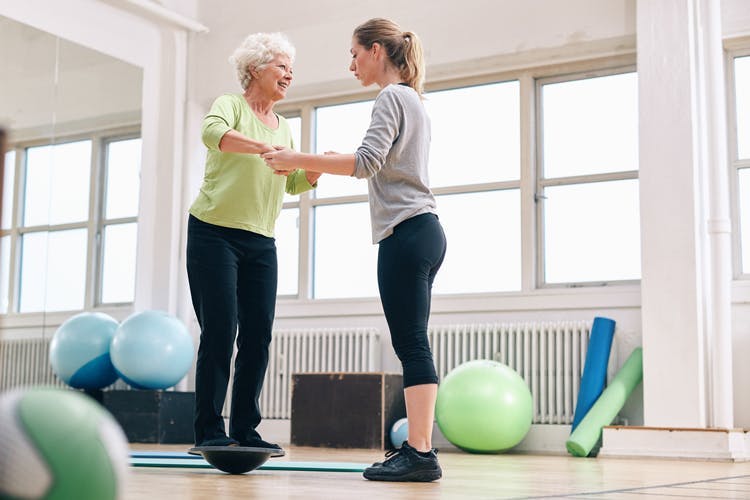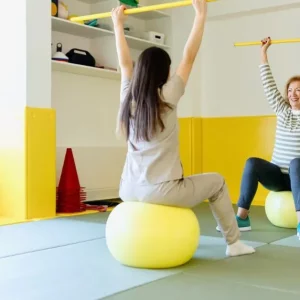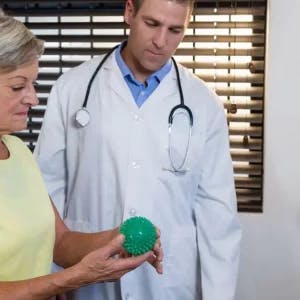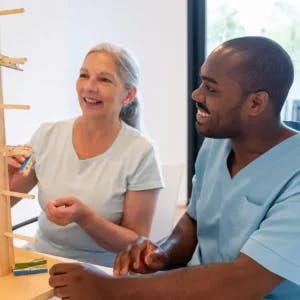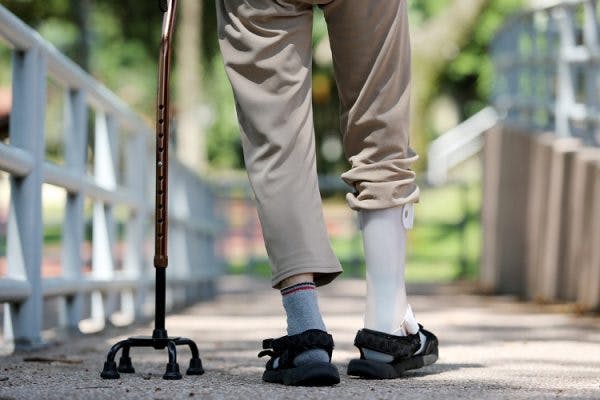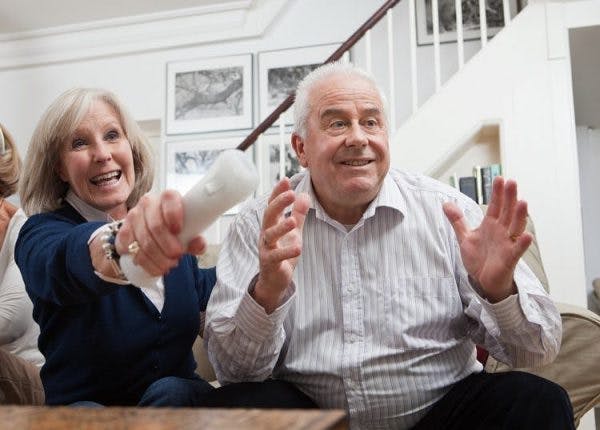Balance is a complex function. It requires coordination of the legs, feet, and core. Even the arms play a role in balance as they swing alongside the body to provide stability while walking. Therefore, regaining balance after a stroke is no easy task. However, using effective, evidence-based rehabilitation methods, it can be possible.
To help survivors find the best ways to regain balance after stroke, this article will describe the best data-driven treatments and the mechanisms behind their effectiveness. Details regarding the recovery outlook will also be discussed.
Please use the links below to jump directly to any section of this article:
- Causes of balance problems after stroke
- How rehabilitation can lead to recovery
- Best methods to regain balance after stroke
- Recovery considerations
What Causes Balance Problems After Stroke?
A stroke occurs when there is a disruption to the blood flow to or within the brain, resulting in damage to the affected areas of the brain. Depending on where in the brain the stroke occurred, survivors may experience numerous secondary effects, including impaired balance.
Many areas of the brain are involved in balance, including:
In addition to areas of the brain being labelled by structure, the brain can be divided into left and right hemispheres. Each hemisphere of the brain controls the opposite side of the body. Strokes usually affect either the left or right hemisphere while leaving the other side undamaged.
Damage to only one side of the brain results in motor difficulties on the opposite side of the body, such as hemiplegia (paralysis on half the body) and hemiparesis (weakness on half the body). Since balance requires coordination from both sides of the body, survivors with hemiplegia or hemiparesis often experience impaired balance.
While motor functions are essential to balance, the sensory systems also play a vital role. Changes in a person’s vision, sensation, vestibular system (sense of head motion and spatial orientation) and/or proprioception (sense of where the body is positioned in space) after a stroke can all impact one’s balance.
Poor balance puts stroke survivors at a greater risk of falling, which can compound injuries and lead to further complications. For this reason, many therapists prioritize balance therapy during inpatient and outpatient rehabilitation. Pursuing rehabilitation is vital to regaining balance after stroke.
How Rehabilitation Can Help Stroke Survivors Regain Balance After Stroke
A stroke affects the brain’s ability to effectively perform functions associated with damaged areas. For example, when a stroke has damaged the brain’s ability to correctly send signals to certain muscles of the body, the muscles may become difficult or impossible to move.
Fortunately, the brain can be adaptively rewired, allowing healthy brain tissue to take over responsibility for functions controlled by damaged areas. This process is known as neuroplasticity, and is essential for regaining balance after stroke.
Neuroplasticity is activated through repetitive practice. Whenever an exercise or activity is practiced, the neural pathways in the brain responsible for that task are strengthened. More practice results in stronger neural pathways, and an improved performance of the task.
Therefore, to regain balance after stroke, survivors should consistently practice balance therapy exercises. While these exercises may look different depending on whether impaired balance is a result of affected motor or sensory functions, repetitive practice will help to rewire the brain and promote lasting improvements.
Best Methods for Regaining Balance After Stroke
There are a number of effective interventions to help survivors regain balance after stroke. Because every stroke is different, each survivor will benefit from different rehabilitation methods.
It’s often helpful for survivors to try different methods to see which works best for their needs. Consulting with a physical or occupational therapist can also help survivors gain personalized recommendations on which rehabilitation techniques may be optimal.
Here are some of the best ways to regain balance after stroke:
1. Consistent Rehabilitative Exercise
A prominent cause of poor balance after stroke is impaired muscle strength and coordination in the legs and core. Therefore, pursuing exercise therapy to improve strength and coordination in both the legs and the core muscles can result in improved balance.
Physical therapists are excellent resources to consult regarding which leg and core exercises may be most effective for a survivor’s specific condition. Studies have demonstrated that in addition to generalized rehabilitative exercises, practicing functional weight-shifting exercises, balance tasks, and gait training can be especially effective.
Practicing rehabilitative exercises daily, or at least most days, is important because the brain needs consistent stimulation to rewire itself as efficiently as possible. Establishing an engaging and motivating home exercise program can encourage consistent practice and an optimal recovery.
2. Address Foot Drop (as appropriate)
A common cause of balance challenges after stroke is a condition called foot drop. Often occurring in survivors with hemiplegia, foot drop impairs the ability to lift the front portion of the foot. This causes the foot to drag on the floor while walking, impairing balance and increasing the likelihood of falling.
Using a brace called an ankle foot orthotic, such as the Flex AFO, is a common treatment for addressing impaired balance due to foot drop. However, while using an AFO may keep the toes from dragging, it does not help survivors actually improve their balance or their mobility. Therefore, in order to truly improve, it is important to address the root cause of the foot drop by practicing foot drop exercises.
3. Aquatic Therapy
In addition to practicing rehabilitative exercises on land, many survivors experience significant improvements through aquatic therapy. Sometimes referred to as hydrotherapy, aquatic therapy involves practicing rehabilitative exercises in a warm pool.
Aquatic therapy has numerous benefits for survivors experiencing balance deficits. The warmth of the water can reduce muscle pain and tension, the water’s resistance can improve strength, and practicing in a pool usually reduces the fear of falling.
Furthermore, multiple studies have found that aquatic therapy can be an effective intervention for improving balance after stroke. These factors make aquatic therapy an excellent treatment option to help survivors with regaining balance after stroke.
4. Virtual Reality Training Programs
In recent years, virtual reality training programs have become frequently used as a form of therapy for stroke survivors. Studies have demonstrated that many virtual reality training programs can even be more effective than conventional therapies for improving balance.
Virtual reality training may take on many forms, including using a headset to visually simulate different situations or using a balance board to track weight-shifting movements. Games, such as those in Nintendo Wii Fit, are frequently used to improve engagement in balance activities.
Virtual reality training programs are often are very motivating for survivors and have the ability to provide detailed, real-time visual, auditory, and tactile feedback on performance. Since many virtual reality training programs use readily available devices, survivors also have the ability to purchase many programs for home use. Therefore, virtual reality training programs are frequently recommended for survivors to use when working toward regaining balance after stroke.
5. Yoga
Practicing yoga is another method to help survivors with regaining balance after stroke. Yoga includes practicing postures designed to be modifiable, allowing it to be adapted to almost any survivor’s skill level.
In addition to helping with motor skills such as balance, yoga is also able to promote relaxation and mindfulness while reducing stress and anxiety. Practicing yoga can also reduce the risk of falls among stroke survivors.
While yoga classes are offered in many areas, it is best for survivors to discuss modified yoga postures with a physical or occupational therapist to learn which poses are safe and appropriate for them. In fact, some therapists are designing yoga programs specifically for stroke survivors, which would be an optimal opportunity to work on regaining balance after stroke in a supportive environment.
While the methods listed above are excellent options for survivors to try, most of them focus primarily on the physical aspects of regaining balance after stroke. Some survivors may also benefit from therapies addressing sensory deficits, cognitive changes, and attentional neglect to restore balance.
As always, survivors should consider consulting with a physical or occupational therapist to learn which specific interventions would be most effective for their needs. Regardless of which type of rehabilitation method used, consistently practicing balance-related exercises and activities is the best way to promote adaptive changes in the brain and lasting functional improvements.
Practical Considerations Regarding Regaining Balance After Stroke
Just as every stroke is unique, each individual’s prognosis and recovery process after stroke is highly variable. However, research has demonstrated that the first 3 to 6 months after stroke are the most vital for recovery. This is because the brain enters a state of heightened plasticity immediately following a stroke, allowing adaptive changes (and subsequently functional improvements) to occur more easily.
At six months post-stroke, between 65 and 85% of survivors regain the ability to walk independently. Since balance is an important component of walking, it stands to reason that the majority of survivors would also have significantly improved their balance along the same timeline.
Practicing balance skills under the supervision of a trained caregiver or therapist when there is a possibility of falling can prevent further injuries and complications. Many stroke survivors with impaired balance find that they may need to use a cane or walker, at least temporarily. While this may be frustrating, these can be excellent tools to improve safety and independence when used correctly.
While stroke recovery varies, survivors can often optimize their recovery by intensively pursuing rehabilitation. Although recovery occurs at different rates for all survivors, there is always hope for recovery, even decades after stroke.
Understanding How to Regain Balance After Stroke
Balance problems may occur due to various effects of stroke, including hemiplegia, hemiparesis, and foot drop. Pursuing rehabilitation to address balance deficits is often the best way to promote improvements. Specifically, consistently and repetitively practicing tasks involving balance can encourage adaptive changes in the brain, thereby helping survivors regain balance after stroke.
While the most effective therapeutic techniques vary from person to person, many find practicing rehabilitative exercises on land, in the water, or through virtual reality programs can greatly improve balance. Alternative treatments, such as yoga, can also be effective in helping survivors regain balance after stroke.
While there is no set recovery timeline, many survivors demonstrate improved balance skills within six months of their stroke. The extent to which improvements are made depends in part on how committed survivors are to practicing the skills needed to improve.
Consulting a physical or occupational therapist to discover which therapeutic methods are best for an individual’s specific condition is highly recommended. With regular participation in rehabilitation, many survivors are able to regain their balance after stroke and continue forward on the road to recovery.

